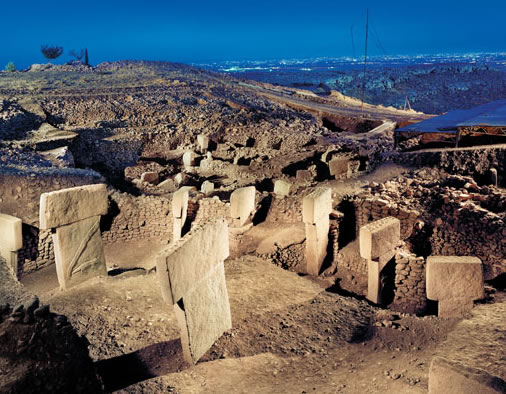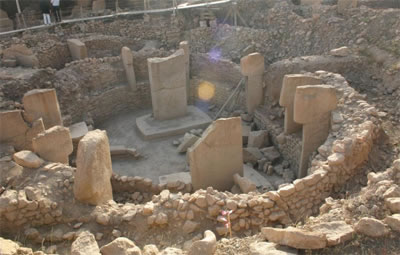Göbekli Tepe - The Skeptic's Dictionary (original) (raw)
Göbekli Tepe (meaning the hill with a belly or belly hill in Turkish) is an archaeological find six miles from Urfa, an ancient city in southeastern Turkey. Some locals claim Urfa is the birthplace of Biblical characters Abraham and Job.
Klaus Schmidt and his team have uncovered many massive carved stones at Göbekli Tepe, which he says are about 11,000 years old. Schmidt dates the site by comparing stone hammers and blades found there to artifacts found at nearby sites that have been carbon dated to 9,000 BCE. He's also done some "limited" carbon dating himself that he says confirms his estimate.
One thing that makes the carved stones at Göbekli Tepe interesting is that the standing stones seem to have been deliberately buried around 8200 BCE. In fact, the standing stones were periodically buried, with new stones built on top of or alongside the old ones. Nobody knows who or why they put the stone circles together and nobody knows who or why they were buried more than a millennium later.

Some claim that aliens quarried, moved, and carved these stones.What methods were used to quarry, move, and carve the stones? We're told that the carvings were done using an "as-of-yet forgotten/undiscovered technology."
Some archaeologists are calling the site "a temple" and "a religious site." The structures probably are grounded in some sort of superstition, but since there's no language associated with these unknown people and no record of them before now, it seems very speculative to associate any gods or supernatural beings to the place. Several writers refer to the monolithic columns as "pillars," as if they knew they were meant to support something. One author even refers to the T-shaped stones as "human forms." Maybe the aliens had no legs or heads. Maybe they brought spiders and scorpions with them from another world. That would explain why the intelligent beings who carved these stones depicted such creatures.
Elif Batuman, who wrote an article about Göbekli Tepe for The New Yorker passes on this rather bizarre bit of logic:
The site has yielded no traces of habitation—no trash pits, no water source, no houses, no hearths, no roofs, no domestic plant or animal remains—and is therefore believed to have been built by hunter-gatherers, who used it as a religious sanctuary.
Schmidt speculates that the site had religious significance, but I fail to see how it follows from all those negatives listed by Batuman that it was used as a religious sanctuary, though both he and Schmidt refer to the monolithic columns as a "temple." By calling it a temple and assuming the columns had a religious purpose, Batuman can say, without sounding like the fantasists who claim aliens built the site,
The findings at Göbekli Tepe suggest that we have the story backward—that it was actually the need to build a sacred site that first obliged hunter-gatherers to organize themselves as a workforce, to spend long periods of time in one place, to secure a stable food supply, and eventually to invent agriculture.
It helps the cause that Charles C. Mann wrote a piece for National Geographic on Göbekli Tepe entitled "The Birth of Religion." A graduate student who gave Batuman a tour of the site convinced him that the columns "are almost certainly humanoid figures, with long narrow bodies and large oblong heads." They see erect penises in various sculptures and stones. Good for them, but that might tell us more about these modern speculators than about the ancient people who put these monuments here.
What Schmidt has found is a collection of standing stones arranged in circles. He is simply guessing when he calls it a "place of worship." There are four rings of partially excavated pillars on a hillside. (There are allegedly as many as sixteen more circles buried nearby, which raises the question: Why would any group erect 20 temples right next to each other?) The rings have two large T-shaped stones in the center encircled by slightly smaller stones facing inward. The tallest columns are 16 feet high and, according to Schmidt, weigh between seven  and ten tons. Some columns are blank; others have carvings of foxes, lions, spiders, scorpions, snakes, and vultures. Unlike the animal paintings in caves done by earlier Neolithic peoples, these animals are not the kind you hunt. There is abundant evidence that animals were butchered and cooked on site. Joris Peters, an archaeozoologist from the Ludwig Maximilian University in Munich, specializes in the analysis of animal remains. He has examined more than 100,000 bone fragments from Göbekli Tepe. None have come from domesticated animals. Most of the bones have been gazelle bones, but he's also identified boar, sheep, red deer, vultures, cranes, ducks, and geese.
and ten tons. Some columns are blank; others have carvings of foxes, lions, spiders, scorpions, snakes, and vultures. Unlike the animal paintings in caves done by earlier Neolithic peoples, these animals are not the kind you hunt. There is abundant evidence that animals were butchered and cooked on site. Joris Peters, an archaeozoologist from the Ludwig Maximilian University in Munich, specializes in the analysis of animal remains. He has examined more than 100,000 bone fragments from Göbekli Tepe. None have come from domesticated animals. Most of the bones have been gazelle bones, but he's also identified boar, sheep, red deer, vultures, cranes, ducks, and geese.

Schmidt is convinced it was a holy place. It certainly was a special place. A lot of time, energy, planning, and skill went into its construction, but I think it's a little early to be calling it a temple or collection of temples, an observatory, a restaurant, a butcher shop, the Garden of Eden, a hunting lodge, an homage in stone to Noah's ark, or an alien outpost.
There is no end to Schmidt's speculations. He thinks these ancient Stone Age folks might have had beer and drugs. He thinks Göbekli Tepe was abandoned because the people “did not need it anymore. Now they are farmers and they find new expressions of their religious beliefs.” Yes, and maybe the aliens had a thing about erections and nasty animals.
If you desire to know more about the aliens and Göbekli Tepe, tune in to the (Pseudo)History Channel and watch “Ancient Aliens: Unexplained Structures” (Dec. 16, 2010). If you can't find the episode, go here and watch about 8 minutes of wild speculation from fringe characters like Linda Mouton Howe and Graham Hancock.
Better yet, read Edwin's review of this "legitimately fascinating archaeological work [that] is being overshadowed by the sensationalist assertions of a motley crew of cult historians." Edwin hangs out at Skeptical Cubefarm.
further reading